Key takeaways:
- Mindfulness practices involve being present and aware of thoughts and feelings without judgment, which can transform daily activities into profound experiences.
- Mindfulness is particularly beneficial for women, helping to manage stress, foster self-compassion, and enhance connections with others.
- Incorporating simple techniques like mindful breathing and walking can seamlessly integrate mindfulness into daily routines, fostering greater awareness and peace.
- Overcoming challenges in mindfulness, such as busy schedules and racing thoughts, can deepen one’s practice and reinforce the importance of presence over perfection.
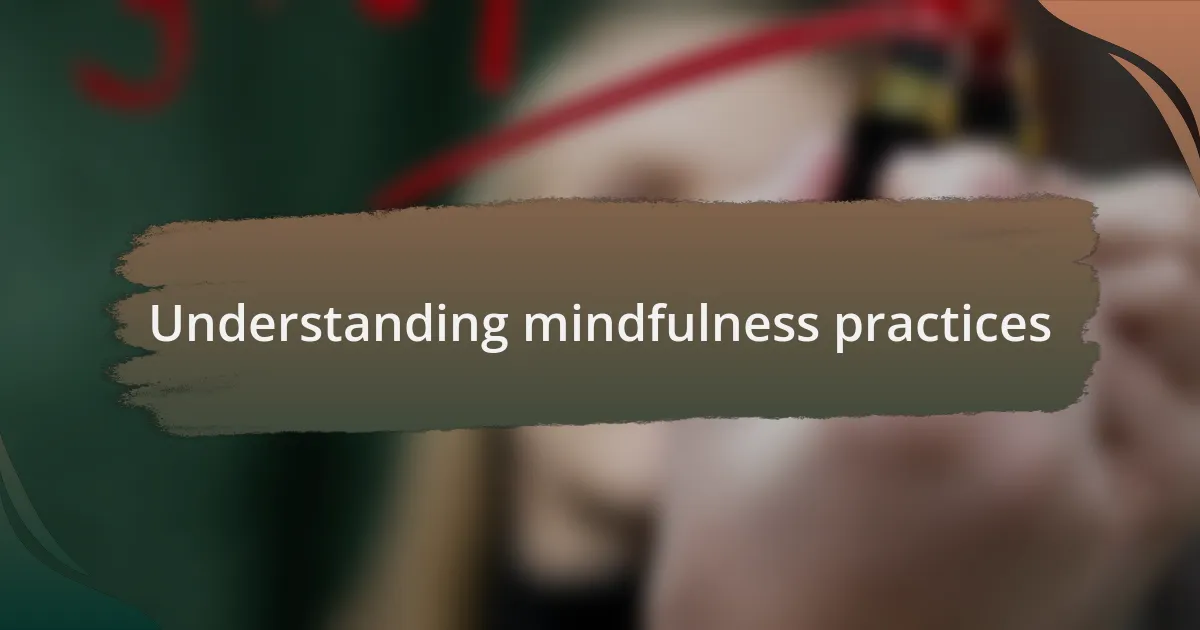
Understanding mindfulness practices
Mindfulness practices focus on being present in the moment while acknowledging thoughts and feelings without judgment. I still remember the first time I sat down for a meditation session; I was amazed at how my mind raced, filled with a whirlwind of thoughts. It makes you wonder, doesn’t it? How often do we truly pause and connect with the present, rather than getting lost in constant distractions?
At its core, mindfulness is about awareness—being fully engaged with our experiences, whether it’s enjoying a cup of tea or taking a walk in nature. I often choose to engage in mindful walking, intentionally paying attention to each step I take. Have you ever noticed how a simple act like walking can become a profound experience when you really focus on your surroundings and sensations?
Practicing mindfulness can be transformative, especially for women navigating the complexities of daily life. I recall a week when I felt overwhelmed with responsibilities; carving out time for mindfulness allowed me to cultivate a sense of inner peace. Isn’t it fascinating how such simple practices can foster a deeper appreciation for life?
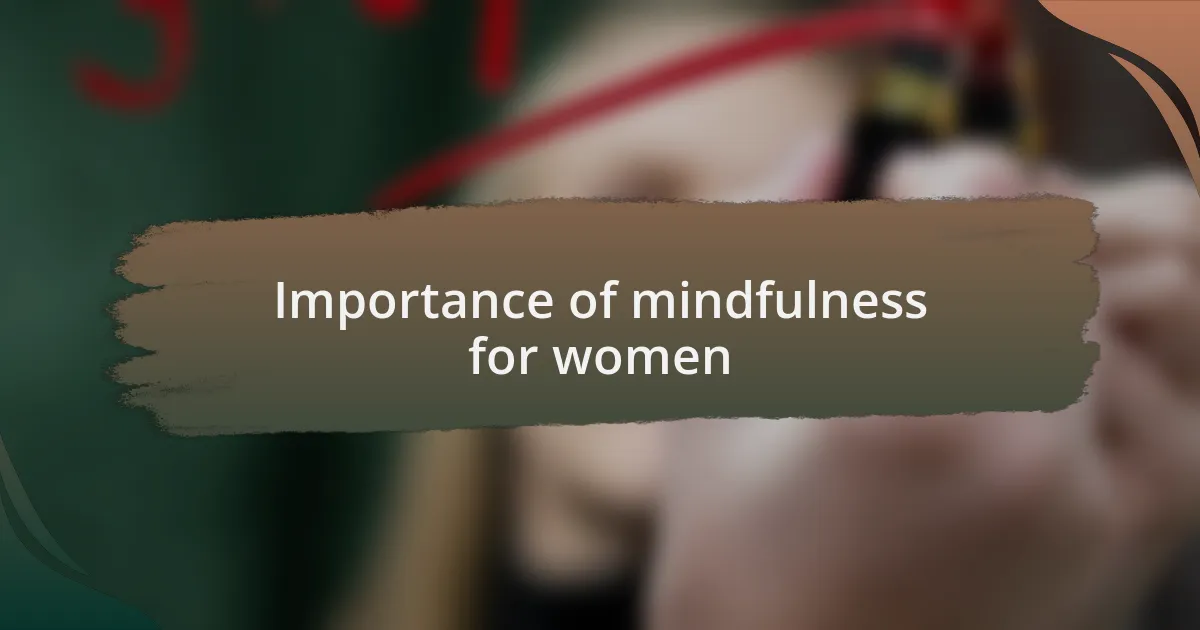
Importance of mindfulness for women
Mindfulness is incredibly important for women as it provides a vital tool for managing stress and promoting emotional well-being. I recall a particularly challenging period in my career when balancing work and personal life felt overwhelming. During this time, I discovered that taking just a few minutes a day to practice mindfulness allowed me to center my thoughts and regain clarity. Have you ever found that just stepping back can help you see the bigger picture?
Moreover, mindfulness fosters self-compassion, which is essential for women who often juggle multiple roles. I remember feeling guilty for taking time for myself until I realized that prioritizing my well-being was not an indulgence, but a necessity. In moments of mindfulness, I learned to acknowledge my own needs without judgment. How often do we forget to be kind to ourselves in the midst of life’s demands?
The benefits of mindfulness extend far beyond personal peace; they also enhance connections with others. I’ve noticed that when I make a conscious effort to be present, my interactions become more meaningful. When was the last time you truly listened to a friend without distractions? Engaging fully in conversations strengthens relationships, reminding us that mindfulness is not just a personal practice, but a way to enrich our connections with the world around us.
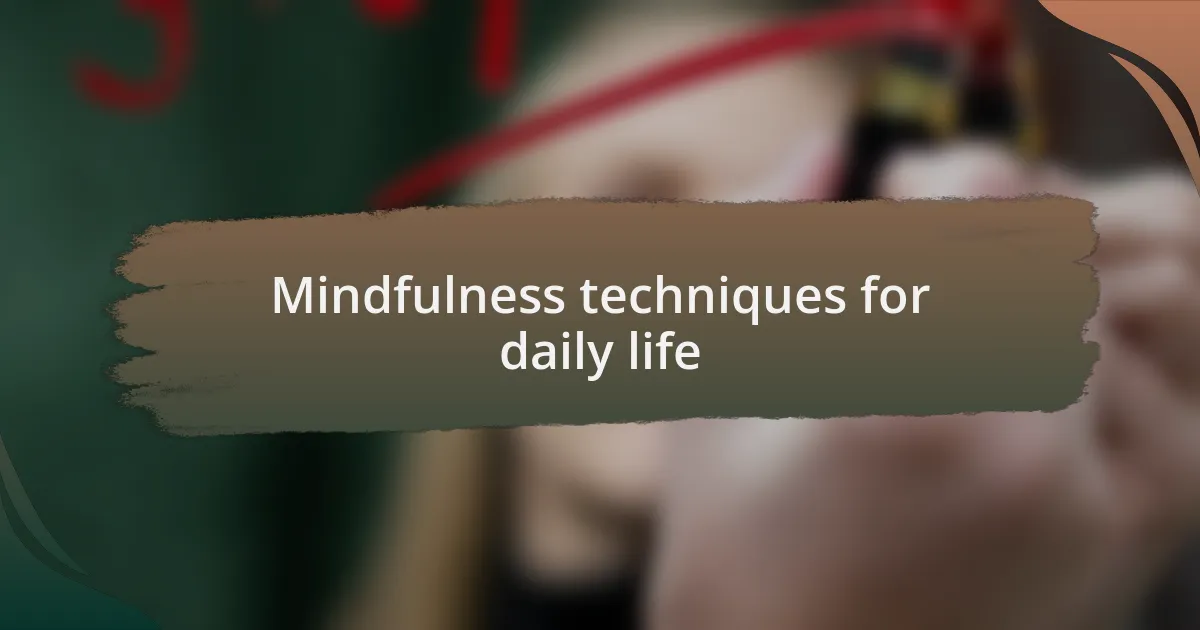
Mindfulness techniques for daily life
Mindfulness techniques can be woven seamlessly into our daily routines, transforming mundane moments into opportunities for presence. For instance, during my morning coffee ritual, I take a moment to savor the aroma and warmth of the cup in my hands. It shifts my focus to the present, grounding me before I dive into the day’s tasks. Isn’t it fascinating how something as simple as a cup of coffee can become a mini mindfulness retreat?
I also find value in mindful walking. It’s not just about getting from point A to point B; it’s a chance to observe my surroundings and breathe deeply. I often walk outdoors, paying attention to the sounds of the leaves rustling or the cool breeze on my skin. Have you ever noticed how these small moments rejuvenate your spirit? This practice helps me cultivate awareness, reminding me that every step can be a mindful one.
Another technique I incorporate is mindful breathing, especially during stressful moments. When I feel tension creeping in, I pause and take three slow, deep breaths. I focus on the rhythmic flow of my breath, which creates a bubble of calm in the chaos. This not only clears my mind but also helps me respond rather than react in challenging situations. How often do we let stress dictate our emotions instead of taking a moment to breathe?
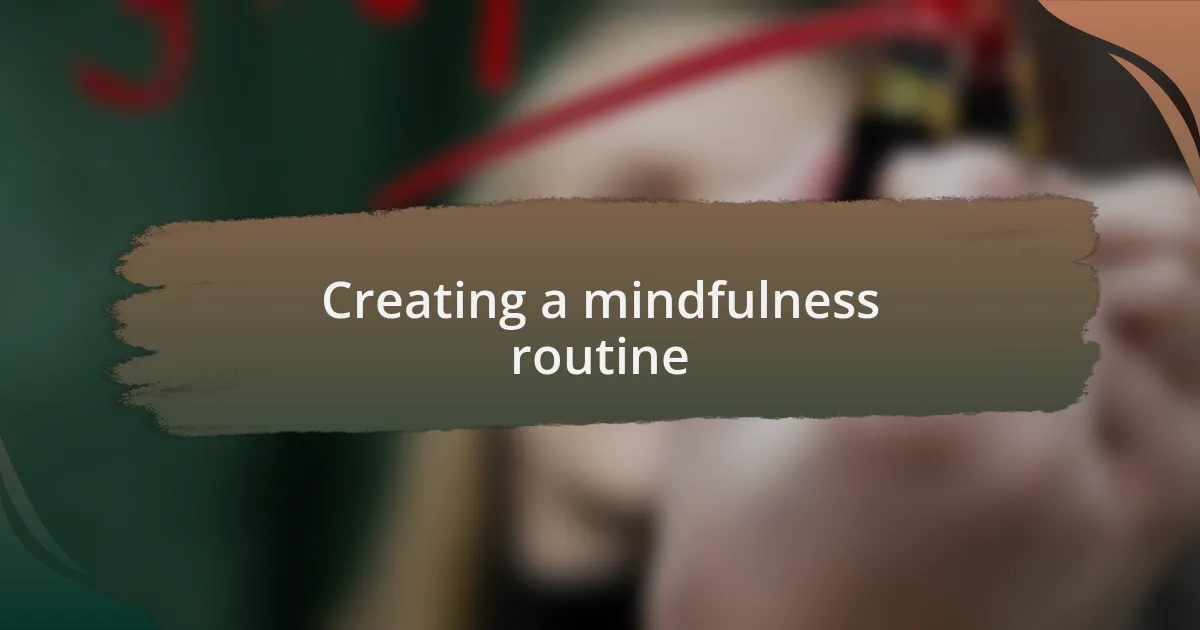
Creating a mindfulness routine
Creating a mindfulness routine begins with consistency. I often set aside a specific time each day for my practice, treating it as an important appointment. When I first started, I chose to meditate every morning right after waking up. The stillness of the early hours makes it easier for me to connect with my thoughts without the rush of the day intruding. Have you ever noticed how the morning light feels so serene? It was a game-changer for me.
To make my routine more enjoyable, I incorporate elements that resonate with me. I love lighting a scented candle and playing soft music or nature sounds during meditation. These simple additions have transformed my practice from a task into a ritual that I look forward to. There’s something uniquely calming about the flicker of candlelight that invites deeper relaxation, don’t you think? It creates a sacred space where I can truly focus on myself.
Tracking my progress has also been incredibly beneficial. I keep a journal to jot down my thoughts and feelings after each session, which provides insight into my emotional landscape. Reflecting on these entries helps me see patterns in my behavior, including moments of growth and areas that need more attention. Has journaling ever helped you understand your feelings better? By documenting my mindfulness journey, I not only solidify my commitment but also celebrate the small victories along the way.
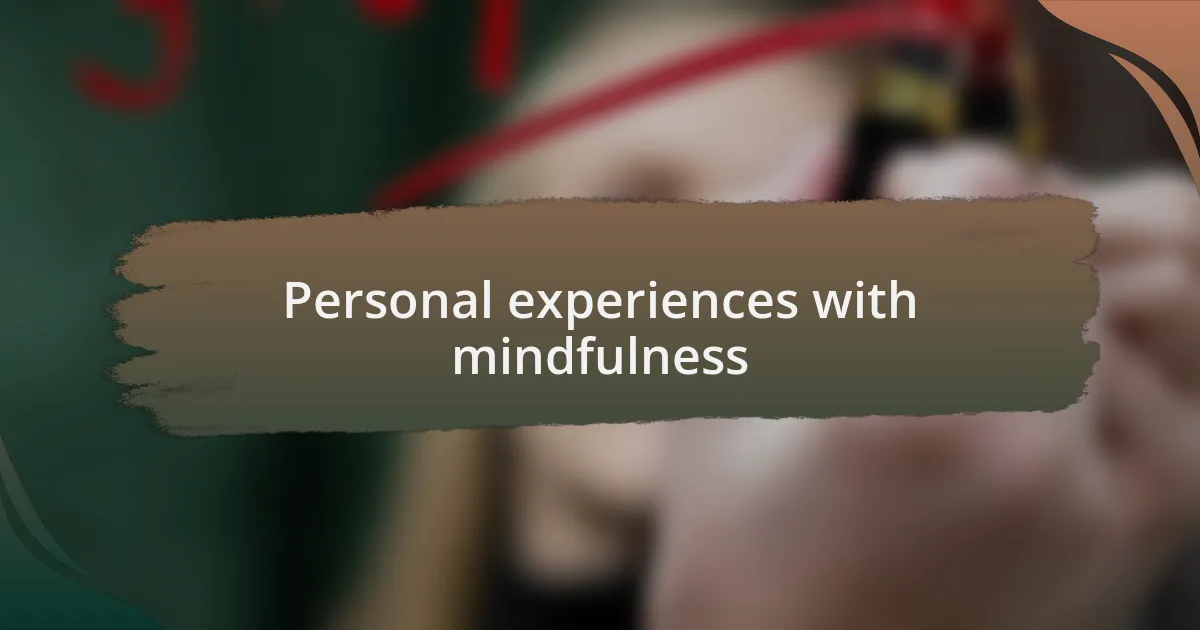
Personal experiences with mindfulness
Personal experiences with mindfulness vary widely, but I can share one that profoundly shaped my perspective. During a particularly stressful week, I decided to take my practice outdoors. Sitting on a park bench, I soaked in the sights and sounds of nature, allowing myself to breathe deeply. It’s amazing how grounding it was to simply observe the rustling leaves and chirping birds. Have you ever experienced a shift in your mindset just by changing your surroundings?
In another instance, a single breath can sometimes shift my entire day. After managing a hectic morning, I paused before entering a meeting. Closing my eyes briefly, I focused on my breath, feeling it deepen and slow. That small moment of mindfulness transformed my anxiety into clarity. Can a mere pause really influence your emotional state? From my experience, it absolutely can.
Finally, I’ve found that integrating mindfulness into daily activities has enhanced my overall well-being. Whether I’m washing dishes or taking a shower, I try to remain present. I concentrate on the sensations of warm water and soapy suds, which unexpectedly cultivates gratitude. Have you thought about how mindfulness can alter even the simplest actions? It turns mundane chores into opportunities for reflection and peace, something I never anticipated would be so rewarding.
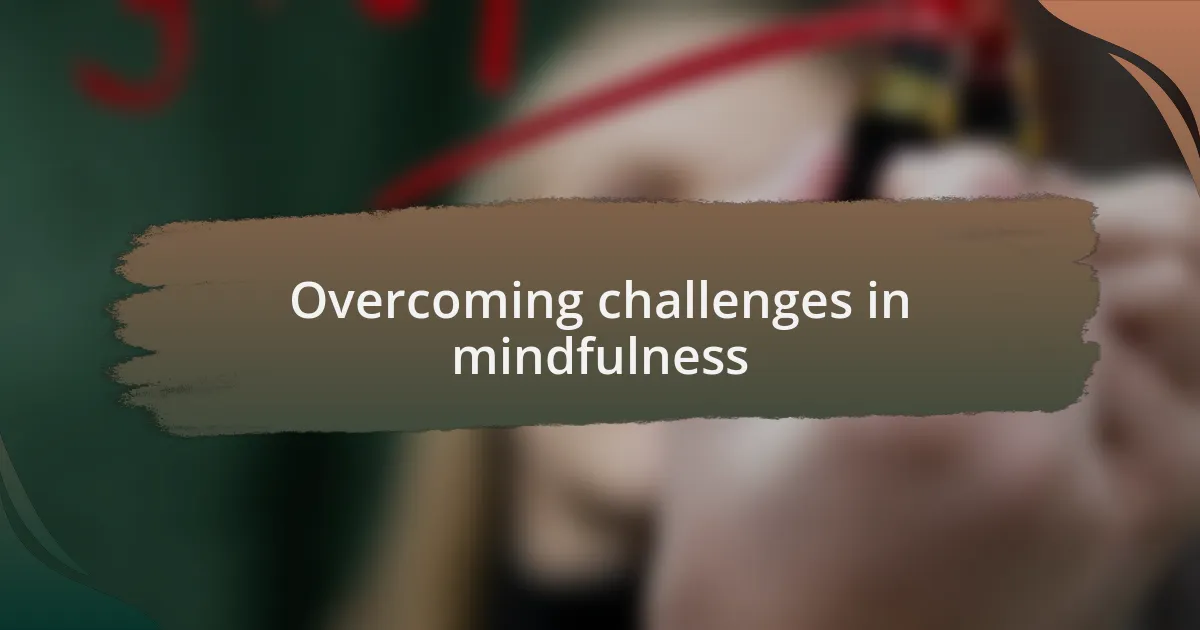
Overcoming challenges in mindfulness
Mindfulness is not without its obstacles, and I’ve encountered my fair share. One of the biggest challenges I faced was to quiet my racing thoughts during meditation. I remember sitting in silence, only to find my mind jumping from one worry to another. It was frustrating! But I learned to acknowledge those thoughts without judgment, reminding myself that it’s okay to stray momentarily. Have you ever felt like your mind is on a treadmill, racing with no end in sight? Recognizing that distraction is part of the process can be liberating.
Another hurdle for me was simply making time for mindfulness. Life can get incredibly busy, and carving out a few moments for myself felt impossible some days. I decided to start small—just two minutes of mindful breathing while waiting for my kettle to boil. Surprisingly, those brief moments made a substantial difference. Have you tried fitting mindfulness into the pockets of your day? Finding those little windows of opportunity can help make mindfulness a part of your daily rhythm.
There are days when I feel my efforts to be mindful just aren’t ‘working.’ During those times, I remind myself that mindfulness isn’t about perfection; it’s about presence. One particular evening, while feeling overwhelmed, I chose to sit with my uncomfortable feelings instead of pushing them away. In embracing that heaviness, I found clarity and a sense of acceptance wash over me. Isn’t it interesting how embracing discomfort can sometimes lead to profound breakthroughs? It’s in these moments that I realize overcoming challenges in mindfulness often deepens my practice.
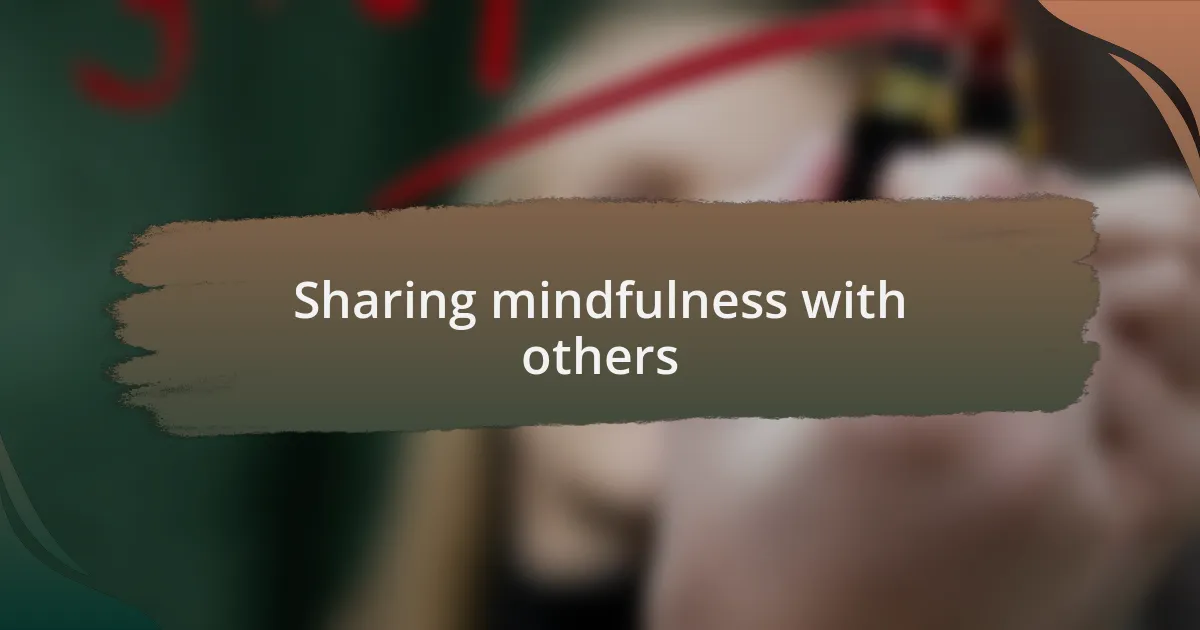
Sharing mindfulness with others
Sharing mindfulness with others can be a deeply rewarding experience. I recall a time when I introduced a friend to a simple breathing exercise. Initially, she was skeptical. Yet, as she began to relax, her expression shifted from doubt to calm—seeing someone unlock that peace felt like witnessing magic. Have you ever seen a friend transform in front of your eyes just by being present with them?
There’s something incredibly powerful about group mindfulness practices, like attending a yoga class together. I remember one session where the instructor encouraged us to share our intentions for the practice. Listening to others express their struggles and hopes made me feel connected, almost like we were weaving a tapestry of shared experiences. It’s incredible how mindfulness can bring us closer, don’t you think?
In my journey, I’ve also found that casual conversations about mindfulness can spark curiosity in others. A simple chat at a coffee shop turned into an exploration of different techniques and resources. It amazed me how sharing my journey inspired my friends to dive deeper into their own practices, creating a community of support. How has discussing mindfulness ever led you to new insights? It reinforces the idea that mindfulness isn’t just a solo endeavor; it flourishes when shared.